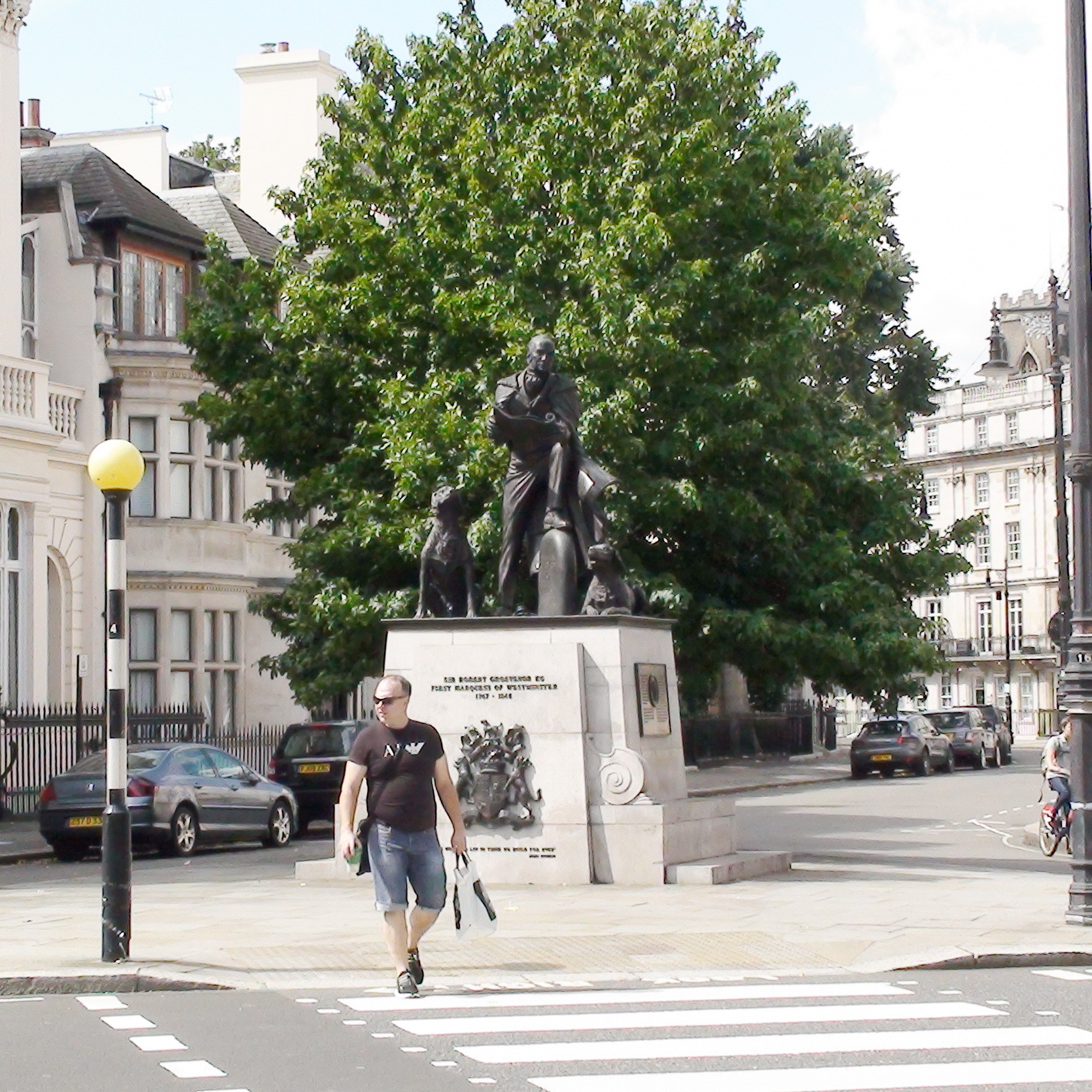Erection date: 1998
{On the milestone on which he props his foot:}
Chester 197 miles.
(Right base of statue:}
Sculpture by Jonathan Wylder 1998
{Front of plinth above a coat of arms:}
Sir Robert Grosvenor KG, first Marquess of Westminster, 1767-1845.
{On (very doggy) coat of arms:}
Virtus non stemma. {Family motto translates literally as 'Valour not Garland' meaning 'Courage not Pomp'.}
{Below coat of arms:}
When we build let us think we build for ever, John Ruskin.
{Right of plinth, surrounding a wheatsheaf:}
The Grosvenor family came to England with William the Conqueror, and have held land in Cheshire since that time. In the seventeenth century Sir Thomas Grosvenor third baronet married Mary Davies a London heiress. Her dowry was part of the manor of Ebury, the land developed by their successors as Mayfair in the eighteenth century, followed by Belgravia and Pimlico in the nineteenth century. In 1979, Gerald Cavendish Grosvenor became the sixth Duke of Westminster. He commissioned this statue in 1997. The hounds on the monument are Talbot dogs introduced to this country by the Normans as hunting dogs. Now extinct, they were the ancestral stock of the modern bloodhound. Talbot dogs were added to the Grosvenor coat of arms in the seventeenth century. The gold wheatsheaf, known in heraldry as a 'garb' appeared for the first time on the coat of arms in 1398.
{Left rear of plinth, beneath a map of Belgravia dated 1821:}
Under the direction of Sir Robert Grosvenor, Thomas Cundy, the Grosvenor Estate surveyor, presented the above layout to the Grosvenor Board in 1825. From Sir Robert's vision arose the elegant buildings, grand squares and colourful gardens that are now Belgravia.
{Right rear of plinth, beneath a map of Belgravia dated 1998:}
The classical terraces of Belgrave Square were designed by George Basevi architect to the Haldimand Syndicate. Most of the buildings were erected under the control of the great Victorian developer Thomas Cubitt.
{Left of plinth surrounding a wheatsheaf:}
Sir Robert Grosvenor succeeded his father as Earl Grosvenor in 1802. Educated at Harrow and Cambridge he became a member of parliament, lord-lieutenant of the County of Flint and was a renowned and enthusiastic art collector. In 1831 he was created Marquess of Westminster and was a sword carrier at the coronation of Queen Victoria in 1837. He was made a Knight of the Garter in 1842. Sir Robert Grosvenor had a vision for a grand development of Belgravia and Pimlico and directed its progress until his death in 1845. The name Belgravia comes from a Grosvenor title of Viscount Belgrave which is taken from a village of that name on the family estate in Cheshire. The plinth on which the statue stands is made of limestone quarried at Halkyn in the County of Flint on land belonging to the family.
Site: Robert Grosvenor statue (1 memorial)
SW1, Belgrave Square, By Wilton Crescent
Credit for this entry to: Alan Patient of www.plaquesoflondon.co.uk


















Comments are provided by Facebook, please ensure you are signed in here to see them